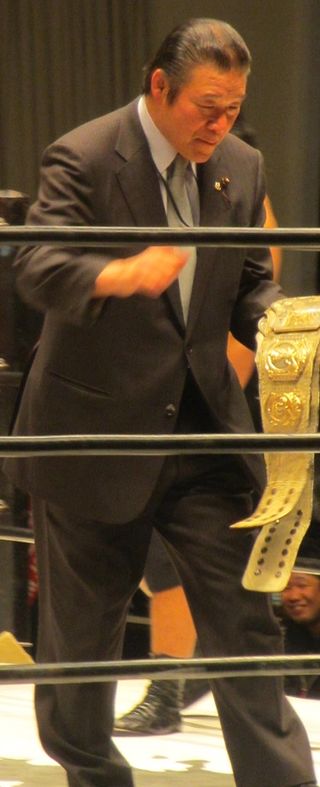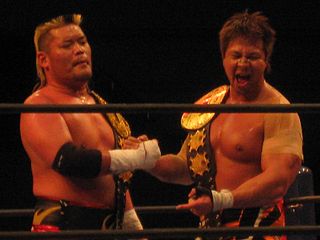Related Research Articles

Kensuke Sasaki is a Japanese retired professional wrestler, mixed martial artist, and founder of the now-defunct wrestling promotion Diamond Ring.

Hiroshi Hase is a Japanese politician and semi-retired professional wrestler who is currently the governor of Ishikawa Prefecture. As a professional wrestler, Hase primarily worked for New Japan Pro-Wrestling (NJPW), and also for All Japan Pro Wrestling (AJPW) and Stampede Wrestling. During his affiliation with AJPW, he also served as the chairman for the Pacific Wrestling Federation (PWF), which is the governing body for all championships in the promotion. Among his numerous title wins, Hase held the WCW International World Heavyweight Championship once, making him a one-time world champion.
Tatsutoshi Goto is a Japanese professional wrestler. He competed primarily in WAR and New Japan Pro-Wrestling (NJPW), and briefly used the name "T2000 Machine". He also briefly competed in World Championship Wrestling (WCW) as part of the nWo Japan.

Takayuki Iizuka, better known by his ring name Takashi Iizuka, is a Japanese retired professional wrestler. He is best known for his 33-year career in New Japan Pro-Wrestling (NJPW), where he was a three-time IWGP Tag Team Champion. He has also worked for Pro Wrestling Noah, where he was a one-time GHC Tag Team Champion.

Shiro Koshinaka is a Japanese professional wrestler who has competed in All Japan Pro Wrestling (AJPW), New Japan Pro-Wrestling (NJPW) and Wrestle Association "R" (WAR) during the 1980s and 1990s. He was also the first IWGP Junior Heavyweight Champion.

Seiei Kimura is a Japanese retired professional wrestler, best known under the ring name Kengo Kimura and for his many years working for New Japan Pro-Wrestling (NJPW) in Japan.
Heisei Ishingun was a Japanese professional wrestling stable led by Shiro Koshinaka during the 1990s, primarily in New Japan Pro-Wrestling.
Michiyoshi Ohara is a Japanese professional wrestler and mixed martial artist, best known for his work in New Japan Pro-Wrestling (NJPW), where he wrestled from 1990 to 2004, winning the IWGP Tag Team Championship with Tatsutoshi Goto in 1999.
Cho-Ten was a professional wrestling team that competed in New Japan Pro-Wrestling on and off from February 1995 - September 2006. The team consisted of Masahiro Chono and Hiroyoshi Tenzan. Cho-Ten is one of the most decorated and successful tag teams in New Japan history. They held the IWGP Tag Team Championship five times and won the 1995 Super Grade Tag League.

Tencozy is a professional wrestling tag team that has competed in New Japan Pro-Wrestling and All Japan Pro Wrestling. Regarded as one of the greatest tag teams in New Japan history, They are seven-time tag team champions. In their history, Tencozy currently hold the third longest IWGP Tag Team Championship reign and are currently the first and only team to have won both the G1 Tag League and World's Strongest Tag Determination League in general and in the same year (2008).
Makai Club, originally Puroresu Kessha Makai Club, was a villainous professional wrestling stable that competed in New Japan Pro-Wrestling. It was led by Tadao Yasuda and managed by Kantaro Hoshino, and its gimmick was that of a group of mixed martial arts fighters and pro wrestlers who worshipped Antonio Inoki as a god.
Seigigun was a professional wrestling stable in New Japan Pro-Wrestling, led by Yuji Nagata.
Black New Japan was a professional wrestling stable that competed in New Japan Pro-Wrestling. Black New Japan was led by Masahiro Chono and was one of many of Chono's anti-New Japan stables.
Team 2000 was a professional wrestling stable that competed in New Japan Pro-Wrestling. Throughout its tenure, T2000 was New Japan's top heel stable.
Wrestling Dontaku 1993 was the first Wrestling Dontaku professional wrestling event produced by New Japan Pro-Wrestling (NJPW). The event took place on May 3, 1993, in Fukuoka, Fukuoka at the Fukuoka Dome. As part of working relationships between NJPW and American promotions World Championship Wrestling (WCW) and World Wrestling Federation (WWF), WCW's Sting and WWF's Brutus Beefcake, Hulk Hogan and Jimmy Hart took part in the event. Professional wrestlers from Japanese promotion Wrestle and Romance (WAR) also appeared at the event.
Wrestling Dontaku 1994 was the second Wrestling Dontaku professional wrestling event produced by New Japan Pro-Wrestling (NJPW). The event was held on May 1, 1994, in Fukuoka, Fukuoka, at the Fukuoka Dome. The event featured thirteen matches; three of which were contested for championships.

Jingu Climax: Battle of Last Summer was a major professional wrestling event produced by New Japan Pro-Wrestling (NJPW). It took place on August 28, 1999, at the Meiji Jingu Stadium in Tokyo, Japan and was televised live on TV Asahi.

Final Dome was a major professional wrestling event produced by New Japan Pro-Wrestling (NJPW). It took place on October 12, 1999 at the Tokyo Dome in Tokyo, Japan and was televised live on TV Asahi.
Battle Formation was an annual professional wrestling event promoted by New Japan Pro-Wrestling (NJPW). The event took place at the Tokyo Dome during the month of April in 1996 and 1997. It was a major event, drawing over 60,000 fans in attendance during both editions. Shinya Hashimoto headlined both editions, cementing his status as the ace of NJPW during that period.
The 1996 Battle Formation was the first Battle Formation event produced by New Japan Pro-Wrestling. The event was held on April 29, 1996 at the Tokyo Dome in Tokyo, Japan. It was a major success with a crowd of estimated 60,000 people and an approximate revenue of $5,700,000 from ticket sales. The event featured competitors from various promotions including Michinoku Pro Wrestling, New Japan Pro-Wrestling, Union of Wrestling Forces International, World Championship Wrestling and Wrestle Association R.
References
- ↑ "Tatsutoshi Goto « Wrestlers Database « CAGEMATCH - The Internet Wrestling Database". cagematch.net.
- ↑ "Michiyoshi Ohara « Wrestlers Database « CAGEMATCH - The Internet Wrestling Database". cagematch.net.
- ↑ "PUROLOVE.com". www.purolove.com.
- ↑ "Untitled Document". Archived from the original on 15 July 2011. Retrieved 6 March 2011.
- 1 2 "CAGEMATCH - The Internet Wrestling Database". Archived from the original on 23 July 2011.
- ↑ "Results". puroresufan.com.
- ↑ "Untitled Document". Archived from the original on 15 July 2011. Retrieved 6 March 2011.
- ↑ "PUROLOVE.com". www.purolove.com.
- ↑ "Results". puroresufan.com.
- ↑ "Results". puroresufan.com.
- ↑ "PUROLOVE.com". www.purolove.com.
- ↑ "Results". puroresufan.com.
- ↑ "Results". puroresufan.com.